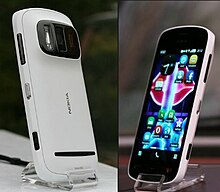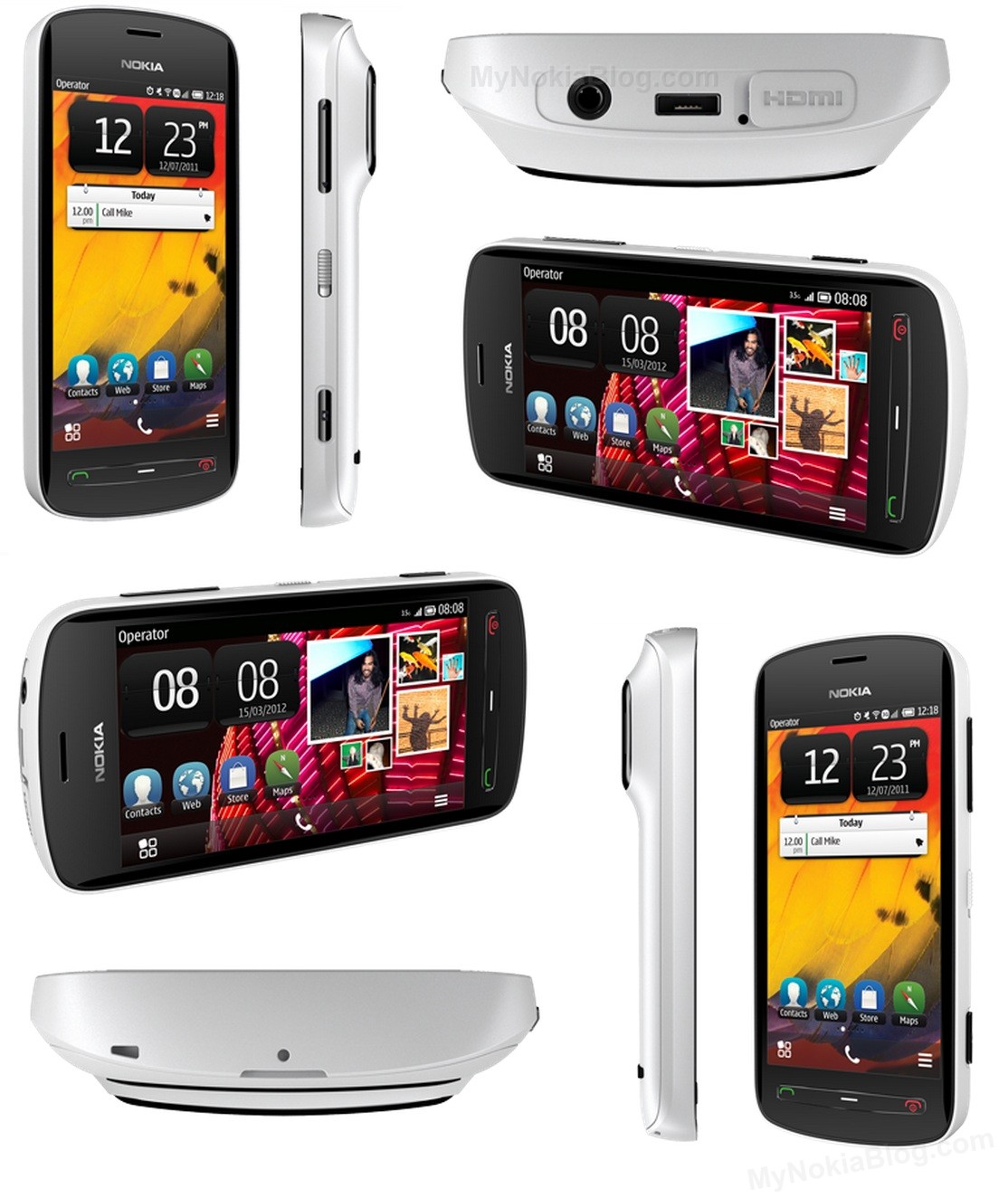 |
|---|
| GENERAL | 2G Network | GSM 850 / 900 / 1800 / 1900 |
|---|---|---|
| 3G Network | HSDPA 850 / 900 / 1900 / 2100 - RM-819 HSDPA 850 / 1900 / 2100 - For Canada | |
| HSDPA 900 / 1900 / 2100 - RM-801 CV | ||
| SIM | Micro-SIM | |
| Announced | 2011, October | |
| Status | Available. Released 2011, November |
| BODY | Dimensions | 116.5 x 61.2 x 12.1 mm, 76.1 cc (4.59 x 2.41 x 0.48 in) |
|---|---|---|
| Weight | 142 g (5.01 oz) |
| DISPLAY | Type | AMOLED capacitive touchscreen, 16M colors |
|---|---|---|
| Size | 480 x 800 pixels, 3.7 inches (~252 ppi pixel density) | |
| Multitouch | Yes | |
| Protection | Corning Gorilla Glass | |
| - Nokia ClearBlack display |
| SOUND | Alert types | Vibration; MP3, WAV ringtones |
|---|---|---|
| Loudspeaker | Yes | |
| 3.5mm jack | Yes |
| MEMORY | Card slot | No |
|---|---|---|
| Internal | 16 GB storage, 512 MB RAM |
| DATA | GPRS | Class 33 |
|---|---|---|
| EDGE | Class 33 | |
| Speed | HSDPA 14.4 Mbps, HSUPA 5.76 Mbps | |
| WLAN | Wi-Fi 802.11 b/g/n | |
| Bluetooth | Yes, v2.1 with A2DP, EDR | |
| USB | Yes, microUSB v2.0 |
| CAMERA | Primary | 8 MP, 3264x2448 pixels, Carl Zeiss optics, autofocus, dual-LED flash, check quality |
|---|---|---|
| Features | Geo-tagging | |
| Video | Yes, 720p@30fps, check quality | |
| Secondary | No |
| FEATURES | OS | Microsoft Windows Phone 7.5 Mango, upgradable to v7.8 |
|---|---|---|
| Chipset | Qualcomm MSM8255 Snapdragon | |
| CPU | 1.4 GHz Scorpion | |
| GPU | Adreno 205 | |
| Sensors | Accelerometer, proximity, compass | |
| Messaging | SMS (threaded view), MMS, Email, Push Email, IM | |
| Browser | WAP 2.0/xHTML, HTML5, RSS feeds | |
| Radio | Stereo FM radio with RDS | |
| GPS | Yes, with A-GPS support | |
| Java | No | |
| Colors | Black, Cyan, Magenta, White | |
| - SNS integration - Active noise cancellation with dedicated mic - MP3/WAV/eAAC+/WMA player - MP4/H.264/H.263/WMV player - Document viewer/editor - Video/photo editor - Voice memo/command/dial - Predictive text input |
| BATTERY | Non-removable Li-Ion 1450 mAh battery (BV-5JW) | |
|---|---|---|
| Stand-by | Up to 265 h (2G) / Up to 335 h (3G) | |
| Talk time | Up to 13 h (2G) / Up to 9 h 30 min (3G) | |
| Music play | Up to 55 h |
| MISC | SAR US | 1.27 W/kg (head) 1.08 W/kg (body) |
|---|---|---|
| SAR EU | 0.94 W/kg (head) | |
| TESTS | Display | Contrast ratio: Infinite (nominal) |
|---|---|---|
| Loudspeaker | Voice 60dB / Noise 59dB / Ring 61dB | |
| Audio quality | Noise -87.3dB / Crosstalk -87.8dB | |
| Camera | Photo / Video | |
| Battery life | Endurance rating 35h |

Software
The Lumia 800 device comes with four Nokia-exclusive applications not included by the default Windows Phone OS: Nokia Drive, a free turn-by-turn navigation system; Nokia Maps;[13] Nokia Music, a free streaming music service and music store; and App Highlights, a service suggesting software based on location and operator. In addition to these applications and services, Microsoft themselves have added Office 365, in which the user can edit documents, create spreadsheets, open PowerPoint presentations, and even make OneNote files. The files created can be stored on Microsoft's SkyDrive cloud service, on the phone itself, and other areas.[14]
[edit]Nokia Collection
In addition to factory-installed Nokia-exclusive Windows Phone applications, the Windows Phone Marketplace contains a Nokia Collection section.[15] As of April 2012, it contains the following additional applications: Nokia Transport, a location-aware public transport schedule and navigation application; Creative Studio, a photo editing application; TuneIn Radio, a local and global radio streaming application; CNN, a news reader and video viewer for the Cable News Network; and WRC Live, an application to follow live timing and media from the FIA WRC series.[16]
[edit]Diagnostic Tool
Just like the Lumia 900, the 800 has the diagnostic tool.
It can be obtained by pressing ##634# on the dial keypad, which should initiate the download after the last # is pressed. The diagnostic tool should appear on the app list under Diagnostics.
On this diagnostic tool, a user can run tests on the following: Accelerometer, ALS, audio loopback, camera, battery status, DTMF, gyroscope, hardware buttons, headset detection, LCD white, lights, life timer, magnetometer, power source, proximity, speaker, touch and vibration. It's also possible to perform all the tests in one run.
Note: This app does not harm the phone, it is an application used by device engineers to test functions of the phone to find whether a certain component is working properly. The app can be uninstalled if a user chooses to do so.[17][18]
[edit]Limitation to WP7
According to Microsoft, due to platform architecture change WP7 phones will not be upgradeable to Windows Phone 8, which will be released in the fall of 2012.[19][20][21] Instead, Microsoft will release Windows Phone 7.8, which will include some WP8 features for existing WP7 phones.[22][23][24]
[edit]Release
The Lumia 800 device was presented along with Lumia 710 by Nokia's CEO Stephen Elop at the Nokia World conference in LondonOctober 2011. In the presentation referred to their devices as 'the first real Windows Phones'.[25]
The London launch was promoted with a massive sound and light show. Nokia and Canadian-based DJ deadmau5 illuminated the banks of the River Thames and the Millbank Tower with a state-of-the-art music and laser show. According to The Daily Telegraph, "The 118 metre building was turned into a canvas for a state-of-the-art light show during which the London skyscraper seemed to buckle and twist".[26][27]

Reported problems
- On-screen keyboard disappearing during typing. Nokia has addressed the problem with a software fix in the update 8107.[40]
- Nokia Lumia 800 is claimed to have "sound quality problems" when using low impedance headphones like the supplied ones. Nokia has acknowledged the issue and is working on a fix.[41]
- Battery life. In December 2011, Nokia confirmed that some Lumia 800 devices do not use the full capacity of their battery.[42] They also state that "only a charger with an output of 1000mA will fully charge your Lumia 800 battery." During 19–20 January 2012, two updates were made available—battery related software update and another of Windows Phone 7.5 Mango build 8107.[43] Nokia has stated that reported issues are fixed with the update and it triples the battery life.[44][45]
- Problems with camera focus in certain conditions. Nokia has confirmed this and is working on a fix.[46]
- Daily Mobile reports an issue with screen flickering.[47]
- Multiple reports of trouble turning device on.[48]

[edit]Connectivity
Like other Windows Phone devices, Lumia 800 uses Microsoft's Zune software on Windows PCs to synchronize user content. For Mac OS X, the device can be synchronized with Windows Phone 7 Connector software. WiFi sync is also available when the phone is charging and connected to the same network as the host PC. Lumia 800 includes the Windows Phone feature of up to 25GB freeSkyDrive storage in Microsoft's cloud service.[37]




